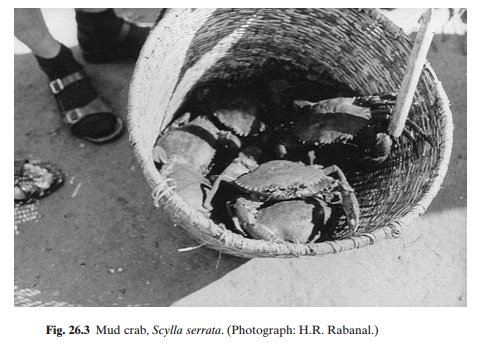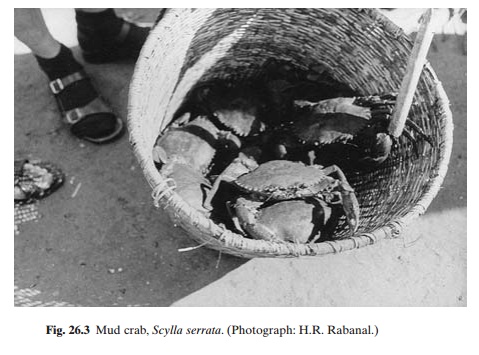Chapter: Aquaculture Principles and Practices: Crayfishes and Crabs
Crabs

Crabs
The feasibility of culturing crabs (family Brachyura) has received attention in some countries because of high market demand and decreasing availability. In recognition of the problems of intensive culture of crabs, which exhibit pronounced cannibalism during the larval and adult stages, some of the early attempts at propagating the economically important species were for the purpose of stocking open waters with larvae.
A more profitable operation that has been in existence for over two centuries in the USA is the production of soft-shell crabs popularly known as ‘shedding crabs’, on a commercial scale. Pre-moult blue crabs (Callinectessapidus) captured from wild stocks are helduntil they moult and the moulted crabs are sold as soft-shell crabs, which fetch higher prices in the market. Wild-caught peeler crabs (premoult crabs) which can be distinguished by colour changes associated with the formation of the new shell, are held for shedding in either a floating box or on land-based tables with a flow-through or recirculating water supply. The peelers are generally sorted according to colour (which indicates the pre-moult stage) and kept in separate floats or tanks. This process of segregation according to colour stage is continued at intervals of four to six hours. Crabs which have shed the shells are allowed to remain in water until they have expanded to their full size, after which they are removed to stop further hardening of the shell.
Culture of Scylla serrata
Opinions may differ on whether shedding crabs can be considered a form of aquaculture, but apart from this the only commercial-scale culture of crabs appears to be that of the serrated crab or mud crab Scylla serrata (fig. 26.3), in some of the Asian countries.

In most coastal fish ponds and impoundments in Asia, the serrated crab forms a subsidiary crop. The young enter with the tidal water and grow there for a period of about six months, when they reach market size. This species is highly priced in local markets, particularly the females with well-developed gonads. Mating and spawning take place in ponds, but the embryonic development and hatching appear to be retarded by low salinities. Even though the holes that crabs make weaken the earthen dikes of coastal ponds, farmers are compensated by the high price they obtain for the crab harvest.
Scylla serrata is reported to spawn through-out the year, with the peak season from May to September. According to Ong (1966) it attains sexual maturity when about 11 months old (carapace width of about 114 mm) under laboratory conditions, but in nature this probably takes place earlier, as observed by Arriola (1940), about five months after hatching. Pair formation can be observed a few days before the precopulatory moult, and a few hours after the moulting mating occurs. The spermatophores deposited in the spermatheca of the female remain viable for months. The time of actual spawning of the eggs varies, but three spawns in a period of five months have been observed, without further moulting and mating. About 2 million eggs may be found attached to the pleopods of a female, but it is suspected that up to half of them fail to attach to the setae. The larvae hatch as planktonic zoeae and, after passing through a number of zoea stages and a megalopa stage, they metamorphose into juveniles which take on a benthic life. Brine-shrimp nauplius has been used as larval food, but does not seem to be the best, as survival rates are low.
Though the techniques of controlled propagation have been demonstrated in laboratories, crab farmers have depended on wild-caught juveniles for seed stock. In the Philippines, juveniles measuring about 2 cm in carapace length are collected by means of bamboo traps, lift nets or scissor nets. Some farmers buy the seed stock from professional seed collectors. They are stocked in milkfish ponds at a low rate of 500–1000 per ha, and repeated stocking and harvesting are practised. In ponds they feed on natural food such as algae, crustaceans and
other animal matter. Some farmers feed them with trash fish or other available animal products, at the rate of about 5–7 per cent of body weight. Before moulting, the crab buries itself in the mud or in holes until its shell becomes hard. Juveniles reach a harvesting size of 11–14 cm carapace width in about six months. Selective harvesting is carried out with traps and any small crabs caught are released back for further growth.
Taiwanese farmers grow the serrated crab in monoculture or in polyculture with milkfish or the seaweed Gracilaria. For monoculture, specially designed tidal ponds with a sandy bottom and a supply of salt water of about 15–30 ppt salinity are used. Ponds with dikes of about 1 m height, made of concrete or bricks with extended crowns to prevent the escape of crabs, are preferred. As only a small number of juveniles are stocked at a time, it is more convenient to have a large number of small ponds (about 350 m2) or larger square ponds divided into four smaller square ponds by means of a central tank (1.5 m2). This central tank is connected by means of water gates with each of the four sections, and serves as both a water tank and a catching tank, very much like the catching ponds in milkfish farms. If the ponds have earthern dikes, bamboo screens are placed obliquely towards the inside of the pond to prevent escape of the stock.
Monoculture of crabs in Taiwan is essentially to fatten them to a stage of full gonadal development. The rearing period is therefore short and generally only one to two months. Mated female crabs are stocked between April and September, at the rate of three crabs (about 7–12 cm carapace width) per m2 water surface. They are fed on soft-shelled snails, trash fish, fish offal and other animal matter. Snails are considered to be the preferred food for maturing crabs. The usual rate of feeding is about 5 per cent of body weight daily, and feeding is usually done after dark.
Harvesting can be done with dip nets baited with trash fish. Plastic or concrete pipes placed on the pond bottom are used as shelter by crabs, and when the pipes are lifted at intervals the crabs can be caught. The most efficient means of harvesting is by making use of their habit of congregating in the central tank when water is let in. It is easy to catch them from thetank with dip nets. Only crabs with fully developed ovaries are removed. For transportation to market, each individual live crab is bound with a wetted heavy straw rope to facilitate handling and also to keep the animal moist.
For polyculture in brackish-water ponds with milkfish, shrimp or seaweeds, larger ponds (0.5–2.0 ha) are used, but oblique fences of bamboo or plastic have to be erected on the dikes to prevent escape of the crabs. Male and female juveniles (1.5–3 cm carapace width) are stocked at rates not exceeding 10 000/ha and are fed the same type of food as in monoculture. Adequate feeding is reported to reduce cannibalism. The crabs reach market size in about six months with a survival rate of 50–70 per cent, depending on the size of juveniles stocked. In certain parts of Taiwan the serrated crab is often reared in rice fields together with shrimps, in rotation with rice after its harvest.
Propagation of crabs in Japan
Seed stock of the Japanese blue crab Neptunuspelagicus is regularly produced in hatcheries forstocking open waters. As with other species of crabs, cannibalism has been a major problem in the grow-out of this species to adult size. The provision of various types of shelters on the pond bottom has been tried with some success in improving survival rates, but commercial culture has not yet become successful. The larval rearing of this species, as well as of Portunus trituberculatus, is carried out in hatcheries. Juveniles have been experimentally raised to adult size in eight to ten months using fresh fish and shellfish as food. But the main interest has been in growing them just to the juvenile stage for stocking the open sea. Berried females collected from the wild are kept in tanks filled with natural sea water of about 33–34 ppt salinity. The hatched early larvae are fed on cultured marine Chlorella, but later larval stages are fed on Artemia nauplii. In about 25 days after hatching the metamorphosis is complete. The juveniles are fed on fresh fish, such as anchovies, and after a further three weeks of rearing are stocked in coastal areas.
The king crab, Paralithodes camtschatica, has also been successfully spawned and the larvae reared in the laboratory. As in the case of other crabs, egg-bearing females are used for propa gation. The eggs hatch out in about a week at temperatures below 10°C. The zoeae are reared in nylon net cages in running water and fed on Artemia nauplii supplemented with shrimp juice, clams and the brown seaweed Laminaria. Net cages are comparatively efficient for rearing post-larvae, but the survival rate has been very low at this stage, probably due to cannibalism and the unsuitability of the food used.
Related Topics